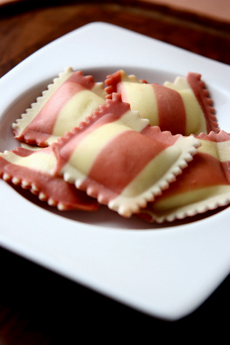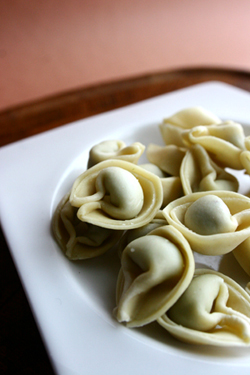

When you buy such nice, fresh pasta, be sure to cook it properly so it doesn’t stick and self-destruct. Photos of Putney Pasta by B.A. Van Sise.
|
KAREN HOCHMAN is Editorial Director of THE NIBBLE.
|
|
February 2008
|
 |
How To Cook Fresh Pasta
Easy Steps To Cooking Fresh Pasta
CAPSULE REPORT: Fresh pasta represents more of a cooking challenge than dried pasta: It will stick more readily. If your pasta is stuffed (ravioli or tortellini, for example), it can break apart and the filling will fall into the water. Here’s how to be sure it doesn’t happen to your pasta.
When pasta is fresh or fresh-frozen, it can easily stick together. Don’t try to pull apart the uncooked pasta: The dough will tear and the stuffing will spill out. And if your ravioli comes in a solid sheet, don’t break it apart: Let it separate naturally in the boiling water. If you buy sheets of frozen ravioli separated by parchment and can’t easily remove the paper, put the pasta and parchment into the water and remove the parchment once it has separated.
Follow these time-honed cooking steps:
- Water. Use a large enough pot and water: one gallon per 9- or 16-ounce package of pasta. Only add the pasta when the water is at full boil. Keep the water at a steady boil throughout the cooking time.
 Salt. Add 1 tablespoon salt per gallon of water (preferably a tastier sea salt), which both firms and flavors the pasta. Salt. Add 1 tablespoon salt per gallon of water (preferably a tastier sea salt), which both firms and flavors the pasta. - Oil. Add 1 tablespoon of olive oil (or other vegetable oil) per gallon of water. As a general rule, don’t add oil to pasta water: It keeps the sauce from clinging to the pasta, and olive oil and water don’t mix. But with fresh ravioli or tortellini that can stick and tear, it can help.
- Stir. Use a slotted spoon to stir the water—gently. Don’t poke the pasta to separate them.
- Al Dente. Especially with stuffed pasta, cook to a firm al dente. Don’t let the pasta get soft—it will tear that much more easily. Remember that hot pasta will continue to cook after it is removed from the water.
- Drain. When the pasta is al dente, gently drain it into a colander and serve it piping hot.
Enjoy that delicious pasta!
Lifestyle Direct, Inc. All rights reserved. Images are the copyright of their individual owners.

|





 Salt. Add 1 tablespoon salt per gallon of water (preferably a tastier sea salt), which both firms and flavors the pasta.
Salt. Add 1 tablespoon salt per gallon of water (preferably a tastier sea salt), which both firms and flavors the pasta.